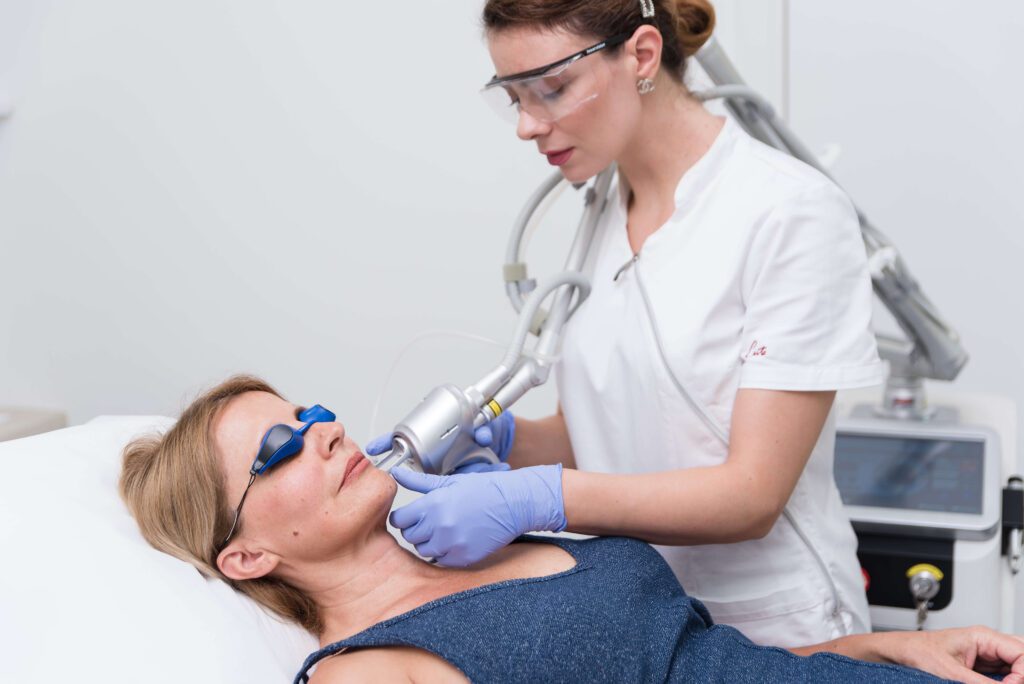Scar Treatment
Scars on the skin represent an undesirable change that occurs due to the action of inflammatory acne, traumatic injury, or postoperatively. Acne scars can occur regardless of whether the acne was mild, moderate, or severe. There are several types of scars. Atrophic scars look like small, often multiple indentations in the skin, most commonly on the face. Hypertrophic scars are raised above the skin’s level, usually white, mainly in the chest area. Keloids represent abnormal growth of connective tissue that spreads beyond the site of injury or acne, most often appearing on the chest or back.

Treatment
In treating scars, we have several treatment options to choose from.
The preferred scar treatment method is the CO2 fractional laser. The CO2 fractional laser is an ablative laser that rejuvenates the skin by remodeling collagen, thereby removing scars, reducing enlarged pores, improving skin texture and smoothness, evening out complexion, strengthening skin tone, and completely rejuvenating it. The synthesis of new collagen and improved skin appearance continues for up to 6 months after treatment. That’s why this treatment is called fractional resurfacing or complete skin renewal.
Micropen microneedling therapy and dermaroller use small needle punctures that cause controlled skin damage up to a depth of 2 mm. The skin responds by forming new connective tissue, improving the appearance of atrophic scars.
Skin Boosters Apocalypsis therapy, based on the principle of phytopeeling combined with 20% fruit acids, acts as a medium-depth peel, improving texture, quality, and skin relief.
Scar removal using the Plasmage device employs controlled release of plasma energy. This causes the excess skin to sublimate (evaporate), and the remainder to retract (tighten), especially suitable for hypertrophic and keloid scars, and due to the smoothing effect, it’s also used for atrophic scars.
Chemical peels we use for this purpose include salicylic-azelaic acid and trichloroacetic acid (TCA), which provide a more uniform appearance of the entire treated area and scars by removing the superficial epidermis and, in the case of TCA, part of the dermis.
Diamond microdermabrasion removes the superficial epidermal layer of the skin, making the skin regenerate, become smoother to touch, and of better texture, suitable for shallow and smaller scars.
Platelet-rich plasma naturally stimulates the formation of new connective tissue using growth factors, regenerating and smoothing the skin, making scars less visible.
Dermal fillers are used to fill atrophic scars, volumizing and smoothing the scarred area.
Carboxytherapy involves the injection of carbon dioxide under the skin, stimulating collagenesis to smooth atrophic scars.
During examination, the appearance and extent of scars are assessed, as well as the appropriate treatment for the type of scar and its location. A combination of treatments provides the best result.
Candidates
Individuals with scars on any part of the face or body who want to improve their appearance should consider these treatments.
Results
With some procedures, results are visible immediately after treatment (dermal fillers), while with most, they become visible a few days later as the skin recovers. Most procedures require repeated treatments at specific intervals, while some need only one treatment.
The CO2 laser generally provides the best results and is the method of choice. Initial results are visible after the completion of exfoliation in the form of smoother skin, better texture, and shallower scars. As the skin matures, which can last for several months, the results get better, and scars become less visible. Depending on the severity of the clinical picture, sometimes only one treatment is enough, but if necessary, it can be repeated after 30-45 days.
Recovery
After preparatory treatments like chemical peels and Apocalypsis SkinBoosters and device treatments like micropen, dermaroller, and diamond microdermabrasion, local redness, sensitivity, and slight skin peeling can be expected a few days post-treatment.
After injectable treatments like dermal fillers, platelet-rich plasma, and carboxytherapy, there may be redness, bruising, and slight swelling.
The Plasmage device leaves small scabs during treatment, which fall off a few days after, leaving light spots that gradually fade. After all methods, using creams with a protective factor is essential, while epithelizing creams assist the healing process.
After the CO2 fractional laser, swelling and redness appear. The swelling lasts 2-3 days, and the redness becomes more intense during this period, with the formation of small scabs on the skin surface, followed by skin peeling, typically ending 6-10 days post-treatment. During this time, the skin needs to be hydrated, and physiological solution wraps can be applied to the treated area. Sun exposure should be avoided until the skin recovers, and the application of high sun protection factor is mandatory if the area is exposed to the sun.